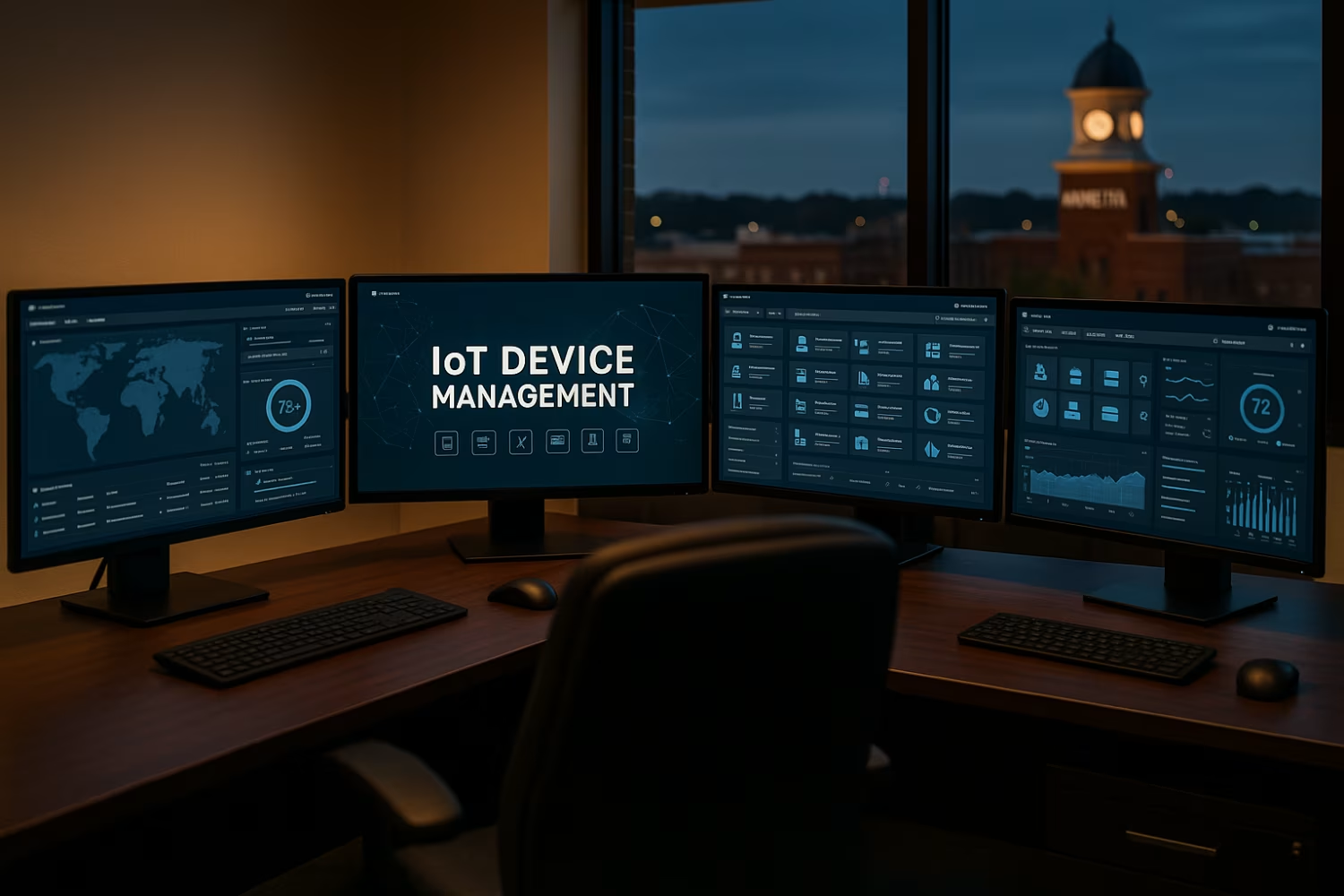
Secure Tunneling for AWS IoT Device Management | Avoid Key Risks
Managing IoT devices remotely is essential, but it comes with serious security risks if not done right. This blog explores how secure tunneling for AWS IoT device management helps protect your infrastructure, reduce downtime, and simplify remote access. We'll also cover how AWS IoT Core, secure tunnel configurations, and local proxy setups play a role in creating a secure connection for your devices. You’ll learn how to deploy, troubleshoot, and maintain a secure tunnel using CLI tools and best practices.
[.c-button-wrap2][.c-button-main2][.c-button-icon-content2]Contact Us[.c-button-icon-content2][.c-button-main2][.c-button-wrap2]
Understanding secure tunneling for AWS IoT device management
Secure tunneling for AWS IoT device management allows you to connect to remote devices without exposing them to the public internet. This is especially useful when devices are behind firewalls or NATs. It provides a secure, encrypted path for communication, which is critical for maintaining data integrity and system safety.
Using AWS IoT Secure Tunneling, you can create a temporary, point-to-point tunnel between your source and destination devices. This tunnel supports bidirectional communication, meaning you can send and receive data securely. It’s ideal for troubleshooting, updating firmware, or managing configurations on devices that are not directly accessible.
AWS IoT Core acts as the control plane, managing the tunnel lifecycle and authentication. The local proxy installed on both ends of the connection handles the actual data transfer. This setup ensures that your IoT devices stay protected while still being manageable from anywhere.

Common mistakes to avoid when using secure tunneling
Even with the right tools, mistakes can compromise your system. Here are key issues to watch out for when setting up secure tunneling for AWS IoT device management.
Mistake #1: Skipping access controls
Not setting proper access controls can expose your tunnel to unauthorized users. Always use IAM roles and policies to restrict who can create and manage tunnels.
Mistake #2: Ignoring tunnel expiration settings
Tunnels should be temporary. Forgetting to set expiration times can leave them open longer than needed, increasing security risks.
Mistake #3: Misconfiguring the local proxy
The local proxy must be correctly installed and configured on both ends. Errors here can prevent the tunnel from working or cause data to be misrouted.
Mistake #4: Not monitoring tunnel usage
Without monitoring, you won’t know if tunnels are being misused or if performance is degrading. Use AWS CloudWatch to track tunnel activity.
Mistake #5: Using outdated software
Running old versions of the local proxy or CLI tools can lead to compatibility issues. Always keep your tools updated to the latest version.
Mistake #6: Overlooking firewall rules
If your firewall blocks the required ports, the tunnel won’t connect. Make sure your network allows outbound connections to AWS endpoints.
Mistake #7: Failing to log tunnel events
Logs are essential for troubleshooting and audits. Enable logging to capture tunnel creation, usage, and termination events.
Key benefits of secure tunneling for AWS IoT device management
Secure tunneling offers several advantages for managing remote devices effectively:
- Enables safe access to devices behind NATs or firewalls
- Supports encrypted, bidirectional communication
- Reduces the need for permanent VPNs or open ports
- Simplifies remote troubleshooting and updates
- Integrates with AWS IAM for access control
- Works with existing AWS IoT Core infrastructure

How AWS IoT, secure tunnel, and device management work together
AWS IoT provides the foundation for secure tunneling by managing device identities and tunnel sessions. The secure tunnel itself is a temporary, encrypted path that connects your source system (like a technician’s laptop) to a destination device. This setup is ideal for remote management tasks like software updates or diagnostics.
Device management becomes easier because you don’t need to physically access the device. You can use the AWS CLI or SDKs to initiate tunnels, send commands, and retrieve logs. This is especially helpful for devices deployed in hard-to-reach locations.
By combining AWS IoT with secure tunneling, you get a scalable, secure way to manage thousands of devices without compromising security or performance.
Strategies for using AWS IoT secure tunneling effectively
To get the most out of secure tunneling, follow these proven strategies.
Strategy #1: Automate tunnel creation
Use scripts or AWS Lambda functions to automate tunnel creation based on triggers like alerts or scheduled maintenance. This saves time and reduces errors.
Strategy #2: Use tags for tunnel tracking
Tag tunnels with device IDs, regions, or project names. This helps you organize and filter tunnel data for better reporting and auditing.
Strategy #3: Rotate credentials regularly
Update IAM credentials and local proxy tokens periodically. This limits the risk if credentials are ever exposed.
Strategy #4: Train your team on CLI usage
The AWS CLI is a powerful tool for managing tunnels. Make sure your team knows how to use it effectively for setup, monitoring, and troubleshooting.
Strategy #5: Limit tunnel scope
Only allow tunnels to access necessary ports and services. This minimizes the potential impact if a tunnel is compromised.
Strategy #6: Integrate with existing monitoring tools
Connect tunnel metrics to your existing monitoring stack. This gives you a full view of system health and tunnel performance.
Strategy #7: Test tunnel performance regularly
Run periodic tests to ensure tunnels are working as expected. This helps you catch issues before they affect production systems.

Practical steps to set up a secure tunnel
Setting up a secure tunnel involves a few key steps. First, register your IoT Thing in AWS IoT Core and attach the necessary policies. Then, install the local proxy on both the source and destination systems. Use the AWS CLI to start a tunnel session, providing the required parameters like device name and timeout.
Make sure your firewall allows outbound connections to AWS endpoints. Once the tunnel is active, you can connect using SSH or other tools. Always monitor the session and close it when done. This process ensures secure, temporary access to your remote devices.
Best practices for maintaining secure tunnels
To keep your secure tunnels reliable and safe, follow these best practices:
- Always set tunnel expiration times to avoid lingering sessions
- Use IAM roles to restrict who can create or manage tunnels
- Monitor tunnel metrics and logs for unusual activity
- Keep all software components updated
- Document your tunnel configurations and procedures
Following these steps will help you maintain a secure, efficient remote management system.

How InfoTank can help with secure tunneling for AWS IoT device management
Are you a growing business looking to manage remote devices securely and efficiently? If you're exploring secure tunneling for AWS IoT device management, we can help you avoid common pitfalls and implement a solution that fits your needs.
Frequently asked questions
How does AWS IoT help with secure tunnel creation?
AWS IoT provides the control layer for managing secure tunnels. It handles authentication, tunnel lifecycle, and permissions. With AWS IoT Core, you can initiate tunnels using the CLI or SDK, making it easier to connect to a remote device securely.
The secure tunnel uses encrypted communication, ensuring data integrity. You can also use IAM policies to control who can create or manage tunnels. This adds an extra layer of security to your IoT Security Management strategy.
What is the role of the local proxy in secure tunneling?
The local proxy acts as the data handler on both ends of the tunnel. It connects to AWS IoT Core and transfers data between the source and destination systems. This setup allows you to manage devices behind firewalls or NATs.
Using the local proxy ensures that only authorized traffic passes through the tunnel. It also supports SSH and other protocols, making it versatile for different use cases.
Can I use AWS IoT secure tunneling for all IoT devices?
Yes, as long as the device supports the local proxy and can connect to AWS endpoints. AWS IoT Secure Tunneling is designed to work with a wide range of IoT devices, including Linux-based systems and embedded hardware.
You’ll need to deploy the local proxy and configure the device properly. Once set up, you can use the tunnel for remote management, updates, and troubleshooting.
How do I troubleshoot a failed tunnel connection?
Start by checking the local proxy logs for errors. Make sure your firewall allows outbound connections to AWS. Also, confirm that your IAM roles and policies are set correctly.
Use the AWS CLI to verify tunnel status and parameters. If needed, restart the local proxy and try again. These steps usually resolve most connection issues.
What are the use cases for AWS IoT tunnels?
AWS IoT tunnels are useful for remote diagnostics, firmware updates, and configuration changes. They allow secure access to devices that are not directly reachable.
These tunnels are especially helpful in industrial settings where devices are behind strict network controls. You can use them to reduce downtime and improve operational efficiency.
How do I set up a secure tunnel using the AWS CLI?
First, install the AWS CLI and configure your credentials. Then, use the start-tunnel command to initiate a session. Provide the device name, timeout, and other required parameters.
Make sure the local proxy is running and properly configured. Once the tunnel is active, you can connect using SSH or other tools. Always close the tunnel when finished to maintain security.



